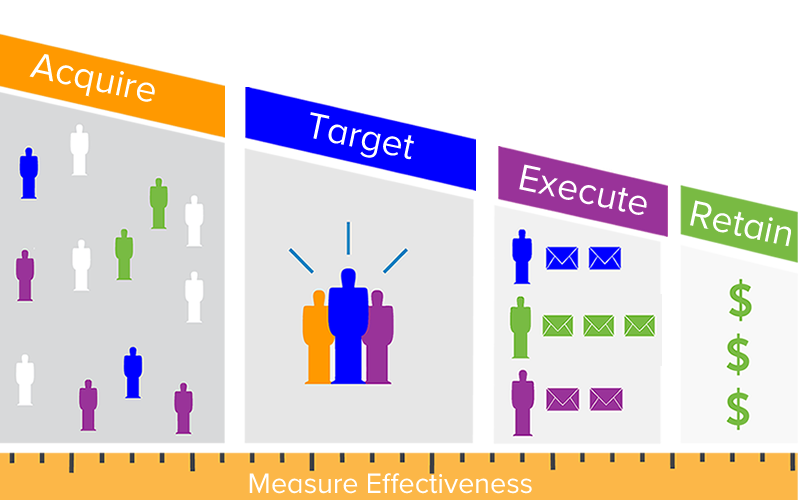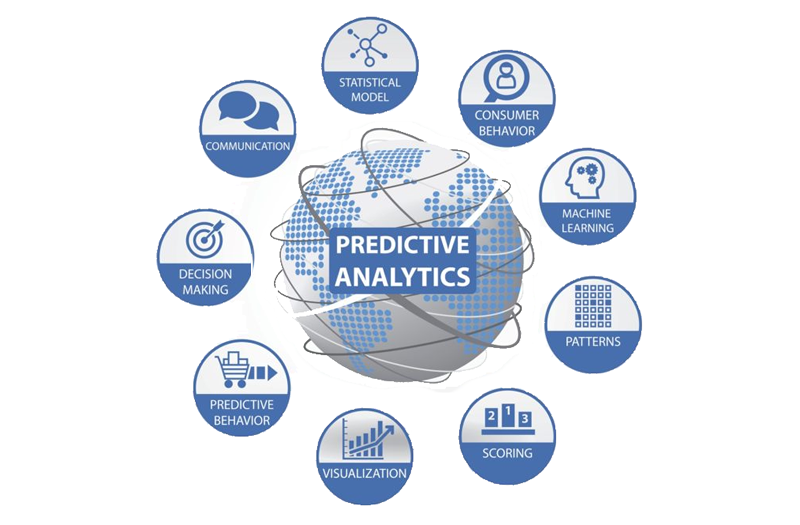What is Predictive Analytics?
Predictive analytics is the utilization of data, statistical models, and machine learning to determine the probability of future outcomes. Marketers using Predictive Analytics typically are forecasting what happens next based on historical, demographic, and behavioral data.
Through careful examination of what has happened in the past, we can determine the greatest likelihood of what outcomes to expect in the future –and respond accordingly. In this way, Predictive Analytics maximizes the power of your data assets and puts your business in the
best position to achieve its goals and succeed.
This Guide describes the
benefits of predictive analytics when properly utilized, and the power of
Predictive Analytics for Marketing Automation. We will also break down the collaborative connection between analytics and automation, and offer insight on how artificial intelligence (AI) will continue to evolve these techniques in the years to come.
What is the Predictive Process?
Predictive Analytics is a cornerstone of data-driven marketing, and is gaining momentum as the scale and breadth of data we capture in an evermore digital and measurable world –keep increasing. Not only can predictive analytics consolidate and simplify data, it makes data useful and valuable by producing insights you can use to acquire and retain customers, and maximize profits. Simply, predictive analytics provides answers to questions you have about the business and the customer, but likely haven’t had viable answers to.
In order to be most effective, a predictive framework must be designed, and algorithms (how to do something, like calculate the number of days most customers take between purchases) must be developed and deployed properly. If not, the consequences spending a lot of time and money with little benefits, and damaging your own credibility. Predictive analytics must be purposeful, and specific, not speculative and overly exploratory in nature.
Fundamentally, predictive analytics in marketing should answer three critical, personalized questions:
- Who should you reach out to?
- What should you offer when you have their attention?
- Which channel should you communicate through?
Obtaining these answers is the chief goal of predictive analytics in marketing. But exactly how is this done?

Filling Blank Spaces in Big Data
There are plenty of holes in your data that inhibit the
most accurate answers to the key questions listed above. However, proper data strategies, predictive techniques, and technologies can fill in these data gaps in order to make the marketing landscape more vivid and readable.
For example, you don’t know the gender of your customers, but you can make reasonable predictions about what their gender is, you can use data from their purchases –did they shop men’s or women’s? You can also use their first name to an extent. In many cases you will have a probablistic assessment of the gender, as opposed to a firm answer. Pat could be Patrick or Patricia –and “Pat” can also shop for his female family members. What’s important to note in this example, the seemingly “simple” data gap on gender does not have to produce an answer on every individual. If you achieved a 50% coverage with a 95% accuracy, you can now use this variable you derived, to predict what would sell next season.
While data collection is more thorough and comprehensive than ever, it is still impossible to know everything about every person – especially regarding their future behavior. The magnitude, diversity, and speed of big data itself have generated a range of obstacles inhibiting its efficient consolidation and implementation.
In order for predictive analytics to be most effective, carefully designed data collection and refinement steps are the first essential step. By obtaining multiple sources of data from the widest variety of consumer channels (both online and offline) and building a 360-degree customer view around each target audience, predictive analytics opens doors to areas previously invisible to marketers.
Predictive Modeling
That is precisely why predictive models are built – to fill in these big data gaps through data mining in order to obtain a cohesive, digestible, and actionable future outlook regarding buyer behavior. These can be used to model your best customer behavior and suggest which actions to take on a personal level. Some applicable modeling techniques include customer segmentation, customer lifetime value models (CLTV), product affinity models, response models, churn prevention models, etc.
Keep in mind that – as with many aspects of life – there are no truly definitive answers in predictive analytics. Conceptually, modeling is about making the most out of what you have available – not about creating flawless datasets.
Model Scores
One critical function of a predictive model is to summarize and condense convoluted, seemingly disparate data points into simple, easy-to-read “scores.”
A basic, yet exemplary predictive modeling method involves generating a personalized likelihood score for each buyer – for example, on a scale of 1 to 10. In this case, the higher the score, the more likely the chance that person will engage with your business, gravitate to your products, respond to offers, and make a purchase via a specific channel (depending on the nature of the models).
For instance, all retailers deal with loyal and valuable customers as well as one-and-done bargain seekers. The latter are undesirables. Without a doubt, attracting the most loyal and valuable buyers (Most Valuable Buyers, or MVBs) who not only come back but continue to buy again over a long period – is the key factor of true retail success.
So how can retailers find MVBs in such a large pool of prospects? It can seem like finding Waldo in a crowded picture.
Determine Your Target
The answer is to “target” such potential MVBs via loyalty or value models that can “mimic” their behaviors.
The following is a breakdown of the high-level steps for developing MVB models for the purpose of prospecting.
- First, we must determine what “value” means in specific terms. Value could mean sheer dollar amount (either lifetime or the past 12 months), frequency of purchase within a set time period, longevity of a relationship, time elapsed since the last purchase, and – more importantly – combinations of all of these factors. To be effective, the target should be neither too large or too small. To start, you can focus on the top 15-20% of customers in terms of lifetime spending level, more than two past purchases, and the last transaction within the past 12 months. Such factors depend heavily on your respective business model.
- Decide what the comparison universe (the opposite of the target) should be, since a model is an algorithmic expression of “differences” between two dichotomous groups. In other words, the non-target is as important as the target universe.
- If finding potential MVB in the “customer base” is the goal, a trained analyst should examine all available historical transaction, promotion and response data, demographic data, and other behavioral data (such as web browsing data) to identify what factors differentiate potential MVBs from all others. For prospecting purposes, mostly non-transaction data would be used (since purchasing behavior wouldn’t be available).
- Once you have the algorithm that would “score” potential MVBs, apply it to the general target universe, so that the user can easily target “high” score individuals.
These are just high-level steps, but the key takeaway here is that defining both the target and the comparison universe is the most critical part of all. To accomplish this, marketers must be on the same page as the analysts who actually develop the models.
In other words, the users must be clear about what they want out of the models, such as longevity of a relationship, high revenue (e.g., high average amount, multiple transactions per year, etc.).
Applying Your Scores
Model algorithms are generally developed with samples. To be useful, final models must be applied to the pool of names used for marketing campaigns.
Once the resultant model scores are available to users, decision makers can easily identify the potentially high-value customers by gauging scores for MVB models (the higher the score, the better). They can then focus on guiding them towards becoming full-scale MVBs through personalized, specialized treatment. On the other hand, the low scorers indicate would-be priority customers who are showing relatively low potential, leading to 1-time purchase.
In another instance, a Loyalty Score would differentiate customers with long-term potential from customers who are showing signs of attrition or are already becoming dormant.
In the latter instance, a series of proactive, targeted, individualized messages could be sent autonomously (see below) in order to prevent churn and “rescue” these fading customers.
An example would be a set of properly spaced, carefully worded emails highlighting “exclusive” discounts designed to get those priority customers re-engaged with your brand and back into the fold.
Winning back potentially high-value customers at this point is crucial. If you lose a customer, the odds of him/her ever returning drop drastically. This results in a series of wasted opportunities..
Without a properly defined, targeted, and coordinated predictive modeling mechanism, you cannot know which customers to prioritize in your marketing campaign. Consequently, precious time and resources would be wasted sending the wrong messages to the wrong people.

Marketing Automation – Making Analytics Actionable
A marketing automation platform allows marketers to synchronize, streamline, and execute their omnichannel marketing campaigns from a single, centralized apparatus.
It is not enough to simply identify and understand the browsing/buying habits of your current and potential customers. In order to initiate a sale, that knowledge must be put into action.
Proper implementation of targeting and messaging will allow you to reach the right customer, at the right time, on the right channel, with the right message. In many cases, this type of advanced personalization can make all the difference between winning or losing a customer.
Aspiration, Adaptation, and Application
Let’s say you’ve put in the work. You’ve asked the right questions, defined your goal, extracted and assembled your data, built your model, and got your answers. Now you want to use that information to grow and nurture your sales and customer base through a targeted marketing campaign.
Keep in mind that customers are becoming more fickle, spontaneous, and impatient than ever. With such a wide variety of consumer channels at their fingertips (web, social, email, mobile, tablets, and other addressable media), their interactions with brands can seem scattershot and haphazard.
Meanwhile, every single message you send should be individually targeted towards a specific buyer who can be at any given point along the customer journey at any time.
Sending such a timely, targeted, personalized message/offer designed to acquire or retain a buyer requires speed, proficiency, and accuracy. Thanks to advances in predictive analytics – where even modeling development can be automated via Machine Learning and AI – the whole process discussed above can lead to success in less time and (with fewer resources) than the past.
Know and Grow Your Buyers [To Their Full Potential]
We’ve reached the point where efficiently measuring and responding to consumer behavior across such a wide array of available channels is beyond the realm of simple legacy Email Service Providers (ESPs).
In this elaborate, multi-dimensional landscape, marketing automation tools can implement algorithms to hone in on your target audiences and proactively adapt to their behavior. As the software ingests more data over time, the system begins to recognize patterns and enhance its recommendations on its own. This radically simplifies and streamlines each customer interaction while simultaneously maximizing business potential.
Forbes recently referenced a series of surveys that shed light on the important role automation plays in the marketing field. Here are some of the findings:
- 67% of marketing leaders rely on marketing automation
- 21% plan to implement a new marketing automation platform in the year ahead
- 82% of marketers recognized a positive return on investment (ROI) from marketing automation and said it makes them more efficient.
With the right combination of predictive analytics and marketing automation software, you will continuously keep your brand ahead of the curve – and on the minds of your customers.

The Future of Predictive Analytics and AI
The scope and efficiency of AI’s capabilities have been growing rapidly and will continue to do so in the years to come. In fact, the amount of funds spent on AI worldwide is predicted to climb to almost $40 billion by 2025.
Meanwhile, predictive marketing platforms are becoming increasingly automated, with less human involvement necessary than ever. Does this mean that humans will eventually be able to just sit back and let the machines do all of the work for them?
The answer is no, because machines still need people to define goals and layout objectives in ways that make mathematical sense. Despite how sophisticated machines may evolve, they still won’t be able to compute and respond to irrational commands.
In addition, machines will not be able to completely understand why humans want specific tasks done, which is a critical component of any marketing campaign.
Basically, machines will continue to increase the speed, scope, and precision of both predictive analytics and marketing automation in the future, but they will still require logical, perceptive humans at the helm to chart a course of action and deliver instructions. After all, automation is really about executing what humans know how to do already.
Conclusion
With the proper predictive analytics and marketing automation software, marketers can utilize big data to sculpt insightful, actionable customer profiles, segments, and models.
Equipped with this valuable information about each individual buyer’s interests, inclinations, and position along the customer journey, predictive marketing platforms can autonomously initiate carefully targeted, personalized conversations across any available channel at any time.
This is the age of one-to-one marketing, where reaching buyers on a personal level via the proper channel is becoming more essential than ever. In a field where every competitor is perpetually striving for relevancy, a predictive marketing automation system is vital to success.
[/fusion_text][fusion_separator style_type=”single solid” hide_on_mobile=”small-visibility,medium-visibility,large-visibility” class=”” id=”” sep_color=”” top_margin=”25px” bottom_margin=”25px” border_size=”” icon=”” icon_circle=”” icon_circle_color=”” width=”” alignment=”center” /][fusion_text]
At BuyerGenomics, a well educated client is our best customer, and we’ve poured our experience and resources into this piece to that end. If you picked up even one or two new insights, you’ve succeeded today.
If you’re interested in learning more about the BuyerGenomics Predictive Marketing Automation Software here.








